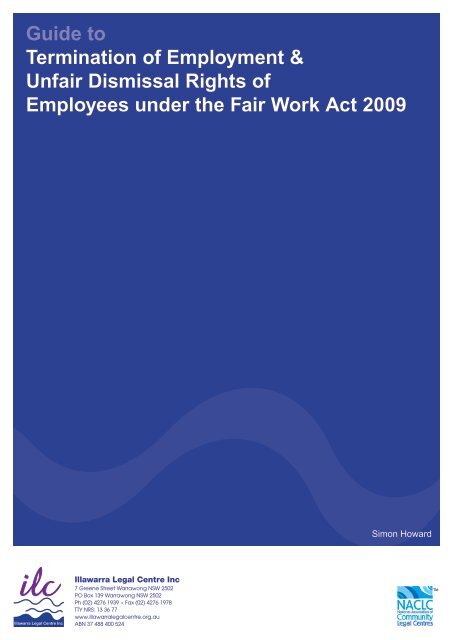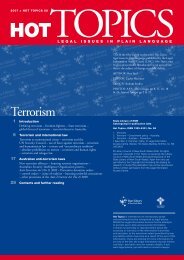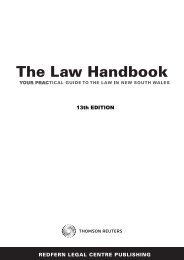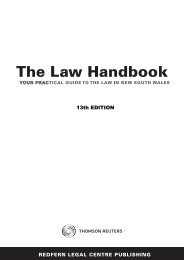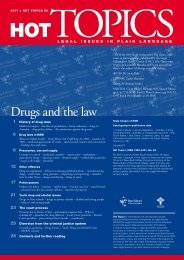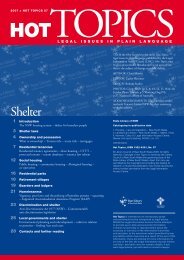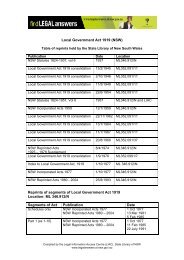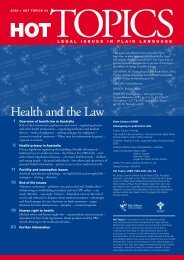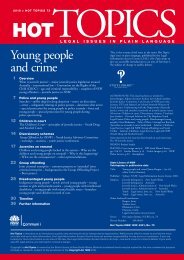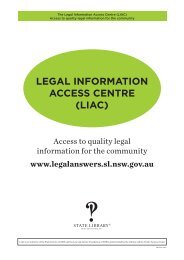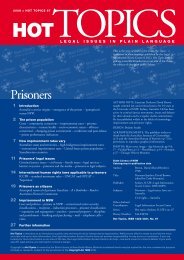Guide to termination and unfair dismissal rights of - Legal ...
Guide to termination and unfair dismissal rights of - Legal ...
Guide to termination and unfair dismissal rights of - Legal ...
- No tags were found...
You also want an ePaper? Increase the reach of your titles
YUMPU automatically turns print PDFs into web optimized ePapers that Google loves.
<strong>Guide</strong> <strong>to</strong>Termination <strong>of</strong> Employment &Unfair Dismissal Rights <strong>of</strong>Employees under the Fair Work Act 2009Simon HowardIllawarra <strong>Legal</strong> Centre Inc7 Greene Street Warrawong NSW 2502PO Box 139 Warrawong NSW 2502Ph (02) 4276 1939 • Fax (02) 4276 1978TTY NRS: 13 36 77www.illawarralegalcentre.org.auaBN 37 488 400 524
Introduction<strong>Guide</strong> <strong>to</strong>Termination <strong>of</strong> Employment &Unfair Dismissal Rights <strong>of</strong>Employees under the Fair Work Act 2009What this guide is about?This guide provides information on the <strong>termination</strong> <strong>of</strong> employment <strong>and</strong> <strong>unfair</strong> <strong>dismissal</strong> <strong>rights</strong> under the FairWork Act 2009 (Cth) (“FWAct”). This is not a guide <strong>to</strong> all potential <strong>rights</strong> <strong>and</strong> legal remedies applicable <strong>to</strong> the<strong>termination</strong> <strong>of</strong> employment.Specifically this guide covers the following <strong>to</strong>pics: 1• The notice entitlements <strong>of</strong> employees in the FWAct.• Employee resignations.• Unfair <strong>dismissal</strong> <strong>rights</strong> <strong>and</strong> protections in the FWAct.This guide does not provide information about the “general protections” provisions <strong>of</strong> the FWAct or the “unlawful<strong>termination</strong>” provisions <strong>of</strong> the FWAct. 2Who is this guide for?This guide is for the information <strong>of</strong> employees.This guide also contains more detailed information about the relevant law mainly in the end notes. These notesmay be <strong>of</strong> assistance <strong>to</strong> employees who would like <strong>to</strong> know more about the law <strong>and</strong> for lawyers who may beassisting <strong>and</strong> advising employees.3
Termination <strong>of</strong> EmploymentWhat is a <strong>termination</strong> <strong>of</strong> employment?In simple circumstances a <strong>termination</strong> <strong>of</strong> employment occurs where an employee’s employment is brought <strong>to</strong> anend. This may occur because <strong>of</strong> the actions <strong>of</strong> the employee or the employer. The employee may resign or theemployer may dismiss the employee, each event will result in a <strong>termination</strong> <strong>of</strong> employment.Some examples <strong>of</strong> a <strong>termination</strong> <strong>of</strong> employment brought about by an employer include the following:3• y Where an employer dismisses an employee on the basis <strong>of</strong> redundancy.•y•y•y•yWhere an employer dismisses an employer for poor performance in their job.Where an employer dismisses an employee for misconduct.Where an employer dismisses an employee for a breach <strong>of</strong> an employment contract or a breach <strong>of</strong> someother legal obligation <strong>of</strong> the employee.Where an employee is forced <strong>to</strong> resign their employment because <strong>of</strong> some action <strong>of</strong> the employer. Forexample, where the employer threatens <strong>dismissal</strong> if the employee will not resign.The employer may or may not give notice in any <strong>of</strong> the above circumstances. This does not mean that notice isnot required. In many <strong>of</strong> the above circumstances notice must be given in accordance with the FWAct. Noticeobligations will be discussed further on in this guide.Employment will also terminate in other circumstances. These circumstances may include:4• y Where an employee is employed under a fixed term contract for a specified task or for a season <strong>and</strong> thefixed term contract, task or season comes <strong>to</strong> an end.•y Where employment is under a training contract <strong>and</strong> the training period is completed <strong>and</strong> there is noagreement <strong>to</strong> continue the employment after the training period is completed.•y If the employee dies.Termination events are discussed in more detail with examples further on in this guide.What is a <strong>dismissal</strong>?The FWAct defines a <strong>dismissal</strong> by an employer as follows:(1) “A person has been dismissed if:(a)(b)(c)the person’s employment with his or her employer has beenterminated on the employer’s initiative; orthe person has resigned from his or her employment but was forced <strong>to</strong> do so because <strong>of</strong> conduct, or acourse <strong>of</strong> conduct, engaged in by his or her employer.”Strictly speaking, this definition only applies in <strong>unfair</strong> <strong>dismissal</strong> circumstances under the FWAct. Howeverit provides a helpful short statement about how a <strong>dismissal</strong> may occur. Subsection 1(a) is straightforward.Subsection 1(b) serves <strong>to</strong> reinforce the idea that where an employee is pushed by the employer <strong>to</strong> resign theresignation is a <strong>termination</strong> <strong>of</strong> employment caused by the employer. 54
The employer’s obligations <strong>to</strong> give noticeIn order for an employer <strong>to</strong> terminate an employee’s employment the employer is in many cases required <strong>to</strong> givenotice. Notice is the amount <strong>of</strong> time an employer is legally required <strong>to</strong> give <strong>to</strong> an employee between informing theemployee <strong>of</strong> the <strong>termination</strong> <strong>and</strong> the last day <strong>of</strong> employment.For example, if an employer is legally required <strong>to</strong> give an employee 4 weeks notice, then at least 4 weeks mustpass between the date upon which notice is given <strong>and</strong> the last day <strong>of</strong> employment. The minimum notice requiredis set out in the applicable table in the FWAct. 6 The table is set out on page 6 <strong>of</strong> this guide.Notice may be given pursuant <strong>to</strong> a notice provision in the employee’s contract <strong>of</strong> employment, award or enterpriseagreement. 7 The FWAct contains notice provisions which state the minimum notice that employers must give<strong>to</strong> employees where notice must be given. 8 The notice provisions in the FWAct apply <strong>to</strong> all employees whoseemployment is covered by the FWAct. 9 In NSW all private sec<strong>to</strong>r (non government) employees are covered by theFWAct.Notice by the employer must be given <strong>to</strong> the employee in writing. 10Payment in lieu <strong>of</strong> noticeIn most circumstances an employer is legally able <strong>to</strong> make a payment <strong>to</strong> the employee instead <strong>of</strong> giving actualnotice. 11 Using the example above, if an employer is <strong>to</strong> give 4 weeks notice, the employer may terminateemployment immediately. However, in such a case the employer must pay the employee 4 weeks wages or salary.This is referred <strong>to</strong> as a “payment in lieu <strong>of</strong> notice”.An employer may give an employee a combination <strong>of</strong> actual notice <strong>and</strong> a payment in lieu <strong>of</strong> notice. So usingthe example <strong>of</strong> 4 weeks notice, the employer may require the employee <strong>to</strong> work for 2 weeks <strong>and</strong> then concludeemployment (after the 2 weeks) with a payment for a further 2 weeks in lieu <strong>of</strong> notice.Termination without noticeBefore considering specific notice entitlements, it is important <strong>to</strong> take note <strong>of</strong> the circumstances where the<strong>termination</strong> <strong>of</strong> employment by the employer may occur without the legal requirement <strong>to</strong> give notice. Some <strong>of</strong> thesecircumstances were identified in the earlier parts <strong>of</strong> this guide. The following is a more comprehensive statement<strong>and</strong> explanation <strong>of</strong> the circumstances where notice is not required under the FWAct:• Where an employee is employed for a specified time. 12 For example, where an employee is employedunder a 12 month contract <strong>and</strong> the 12 months pass without an agreement <strong>to</strong> extend the contract. Theemployment will end at the conclusion <strong>of</strong> 12 months without any act <strong>of</strong> <strong>termination</strong> by the employer or theemployee.13• Where an employee is employed for a specified task <strong>and</strong> the task is completed. For example,where an employee is hired <strong>to</strong> work on a special project or a special event <strong>and</strong> the project or specialevent comes <strong>to</strong> an end.Where an employee is employed for the duration <strong>of</strong> a season <strong>and</strong> the season comes an end• . 14Examples <strong>of</strong> this can be found in <strong>to</strong>urism <strong>and</strong> agricultural industries. A snow skiing instruc<strong>to</strong>r may behired only for the winter <strong>and</strong> a fruit picker may be employed only for the season when the fruit is <strong>to</strong> beharvested. In each example employment will come <strong>to</strong> an end with the end <strong>of</strong> the season. Neither theemployer nor the employee will terminate the employment.5
• An employer is not legally required <strong>to</strong> give notice under the FWAct where an employee’s actionsamount <strong>to</strong> serious misconduct. 15 In other words, the notice entitlements under the FWAct do notapply <strong>to</strong> serious misconduct situations. However, it will still be necessary for the employer <strong>to</strong> inform theemployee <strong>of</strong> the <strong>termination</strong> <strong>of</strong> the employee’s employment <strong>and</strong> the reason for the <strong>termination</strong>. Theremay be a dispute between the employer <strong>and</strong> employee about whether or not the conduct occurred orwhether or not it was serious misconduct. The dispute may lead <strong>to</strong> an <strong>unfair</strong> <strong>dismissal</strong> claim or someother legal claim.16• Where the employee is a casual employee. True casual employment consists <strong>of</strong> a series <strong>of</strong>employment periods without an expectation <strong>of</strong> ongoing work. This is a difficult area <strong>of</strong> employment lawbecause there is a fine line between permanent work <strong>and</strong> casual work.For example, a shift worker who is contacted by the employer ahead <strong>of</strong> each roster period <strong>and</strong> is given avariety <strong>of</strong> shifts each time, or sometimes no shifts, will likely be a casual. It is not necessary <strong>to</strong> terminatethe employment <strong>of</strong> this type <strong>of</strong> worker. The employer may simply choose not <strong>to</strong> <strong>of</strong>fer any more shifts. Acontrasting situation would be where a shift worker works the same shifts over a long period <strong>of</strong> time,where the work situation gives the employee a real expectation <strong>of</strong> regular shifts in the future <strong>and</strong> theperiod <strong>of</strong> this arrangement is open ended. It is unlikely that a worker in this situation is truly a casualemployee.• Where an employee works under a training arrangement for a specified period <strong>and</strong> where it isagreed that employment will last for the length <strong>of</strong> the training period. 17 This will <strong>of</strong>ten apply <strong>to</strong>employees described as trainees. However it is important <strong>to</strong> note that this category <strong>of</strong> exclusion doesnot apply <strong>to</strong> apprentices because <strong>of</strong> the specific wording <strong>of</strong> the relevant provision <strong>of</strong> the FWAct.Accordingly, it is necessary <strong>to</strong> give notice <strong>to</strong> an employee who is an apprentice, despite the fact that theapprenticeship may be coming <strong>to</strong> an end.The FWAct contains an anti-avoidance provision <strong>to</strong> protect employees. The provision prevents employers frommisusing the above categories <strong>to</strong> avoid notice obligations. The provision applies where the substantial reasonfor employment under the category was <strong>to</strong> avoid notice obligations. 18 A good example <strong>of</strong> this may be “casual”employment. If an employer hires an employee <strong>to</strong> work regular part time hours but calls the employee a casual <strong>to</strong>avoid notice requirements, the anti-avoidance provision will operate. This will mean that the employer must stillgive <strong>termination</strong> notice under the FWAct.Finally, there are a number <strong>of</strong> other categories <strong>of</strong> employment where the giving <strong>of</strong> notice is not required. Insummary these include: daily hire employees in the building <strong>and</strong> construction industry; some daily hire <strong>and</strong>weekly hire employees in the meat industry. 19Notice entitlement amountsNotice entitlements are calculated in accordance with Table 1 below, which is found in the FWAct. 20 The period <strong>of</strong>employment coincides with the entitlement <strong>and</strong> the stated entitlements are not cumulative.Table 2PeriodEmployee’s period <strong>of</strong> continuous service with the employer atthe end <strong>of</strong> the day the notice is givenPeriod*1 Not more than 1 year 1 week2 More than 1 year but not more than 3 years 2 weeks3 More than 3 years but not more than 5 years 3 weeks4 More than 5 years 4 weeks*IMPORTANT – Where an employee is over 45 years <strong>of</strong> age <strong>and</strong> has completed at least 2 years <strong>of</strong> continuousservice, then the employee is <strong>to</strong> be given or paid 1 extra week <strong>of</strong> notice.6
There are a number <strong>of</strong> matters <strong>to</strong> be aware <strong>of</strong> when using Table 1:• When making a payment in lieu <strong>of</strong> notice, the employer must pay at least the amount that the employerwould have been required <strong>to</strong> pay if the employee worked until the end <strong>of</strong> the notice period. 21• This calculation must be based on full pay <strong>and</strong> must also be based on the hours the employee wouldhave worked. 22• In many cases where the employee worked regular overtime or shifts then the payment in lieu <strong>of</strong> noticeshould also include the overtime or shift amounts the employee would have earned.• The entitlements in Table 1 are located in the part <strong>of</strong> the FWAct, which sets out the National EmploymentSt<strong>and</strong>ards. On this basis the notice entitlements apply as a minimum st<strong>and</strong>ard <strong>to</strong> all employees coveredby the FWAct. 23An award, enterprise agreement or contract <strong>of</strong> employment may set out a greater notice entitlement. If this is thecase then the employer must pay the greater amount. For example, an employee may have been employed for2 years. The employee’s notice entitlement will be 2 weeks notice if Table 1 is used. However, if the employee’scontract states that the employer must give 4 weeks notice, then the employee’s notice entitlement is 4 weeks.At any time an employer <strong>and</strong> an employee may negotiate the employee’s notice entitlement. The employer <strong>and</strong>employee may finally agree that a notice entitlement greater than Table 1 will be given. 24An employee’s obligations when resigning their employmentThe FWAct does not specify the notice period that an employee must give <strong>to</strong> their employer <strong>to</strong> end theiremployment. However, the FWAct also makes clear that awards <strong>and</strong> enterprise agreements may specify anemployee’s <strong>termination</strong> notice obligation. 25Many awards require an employee <strong>to</strong> give the same amount <strong>of</strong> notice as the employer must give under Table 1. 26However the employee is generally not required <strong>to</strong> provide the additional amount applicable where the employeeis over 45 years <strong>of</strong> age.Many awards now contain a provision which permits an employer <strong>to</strong> withhold from an employee an amount <strong>of</strong>money if the employee fails <strong>to</strong> abide by the employee’s notice obligation. The employer may withhold moneyequivalent <strong>to</strong> the value <strong>of</strong> the notice not given. 27 For example if an employee was required <strong>to</strong> give 1 weeks noticebut resigned <strong>and</strong> immediately left employment, the employer may deduct the value <strong>of</strong> 1 weeks wages from theemployee’s final payment <strong>of</strong> unpaid wages.This deduction by the employer must be specifically allowed in an award or enterprise agreement. A clause in acontract allowing a deduction may not be enough <strong>to</strong> allow a legal deduction.Other entitlements that could be relevant in circumstances <strong>of</strong> <strong>termination</strong> <strong>of</strong> employeesWhen an employee is terminated the employee may have other entitlements that must be paid in addition <strong>to</strong>notice.The following is a summary <strong>of</strong> some other entitlements that should be paid on <strong>termination</strong> if they are relevant <strong>and</strong>are owed <strong>to</strong> the employee:28• Any redundancy pay entitlements if the employment is terminated by reason <strong>of</strong> redundancy.• Any outst<strong>and</strong>ing wages (including overtime <strong>and</strong> shift allowances) that are unpaid at the time <strong>of</strong><strong>termination</strong>.29• Any accrued untaken annual leave.• Annual leave loading (on the accrued untaken annual leave amounts). This amount is <strong>to</strong> be paid if theemployee receives this loading under an applicable award, enterprise agreement or contract.30• Any accrued untaken long service leave.• Any commission or bonus amounts that have been earned in periods up until the <strong>termination</strong> date.7
Unfair Dismissal RightsSince 1994, individual employees have been able <strong>to</strong> make some sort <strong>of</strong> <strong>unfair</strong> <strong>dismissal</strong> application <strong>to</strong> anindustrial tribunal. Over the years these <strong>rights</strong> have undergone change. 31 The old “Work Choices” lawssignificantly restricted employee <strong>unfair</strong> <strong>dismissal</strong> <strong>rights</strong>. New <strong>unfair</strong> <strong>dismissal</strong> laws were introduced under theFWAct 2009. The new FWAct laws cover <strong>and</strong> protect more employees than were covered under the WorkChoices laws. 32In broad summary the <strong>unfair</strong> <strong>dismissal</strong> laws in the FWAct have the following features:• y The laws broadly cover employees in Australia - with the exception <strong>of</strong>:• x33Public servants employed by State or Local Governments.•x High income earners.•y•y•y•yThe laws protect employees from <strong>unfair</strong> <strong>dismissal</strong> but only after the fact <strong>of</strong> the <strong>dismissal</strong>. It is not possibleunder the FWAct <strong>unfair</strong> <strong>dismissal</strong> laws <strong>to</strong> obtain an order preventing a potentially <strong>unfair</strong> <strong>dismissal</strong> fromtaking place. 34The laws describe the elements (or matters) that make up an <strong>unfair</strong> <strong>dismissal</strong>. The laws also set outsome circumstances where employees may be excluded from making an <strong>unfair</strong> <strong>dismissal</strong> claim.The laws set out the remedies (legal outcomes) available <strong>to</strong> <strong>unfair</strong>ly dismissed employees. There are onlytwo – reinstatement <strong>and</strong>/or compensation.The laws give power <strong>to</strong> Fair Work Australia <strong>to</strong> deal with <strong>and</strong> decide <strong>unfair</strong> <strong>dismissal</strong> claims. Proceduralsteps are also set out in the laws.Fair Work Australia (“FWA”)FWA is the industrial tribunal established under the FWAct <strong>to</strong> deal with <strong>and</strong> decide on a wide range <strong>of</strong> mattersthat arise under the FWAct. Importantly, all <strong>unfair</strong> <strong>dismissal</strong> applications are made <strong>to</strong> FWA. FWA attempts<strong>to</strong> assist the employee <strong>and</strong> employer <strong>to</strong> resolve the matter in a process <strong>of</strong> conferences which includes“conciliations”. If the conciliation process fails, then FWA will eventually make a decision in favour <strong>of</strong> the employeeor employer based on the merits <strong>of</strong> the claim.FWA is not a court <strong>and</strong> its powers are limited. When FWA is determining an <strong>unfair</strong> <strong>dismissal</strong> claim it can only usethe powers given <strong>to</strong> FWA by the FWAct.FWA cannot:•y•y•y•yOrder an employer <strong>to</strong> pay <strong>to</strong> an employee unpaid entitlements owed <strong>to</strong> the employee, such as unpaidwages or overtime, unpaid holidays or unpaid sick leave etc (except pay lost in a period beforereinstatement).Make an order under the <strong>unfair</strong> <strong>dismissal</strong> laws preventing an employer from dismissing an employee.However FWA can make an order reinstating an employee <strong>to</strong> their former job.Impose a pecuniary penalty (fine) on an employer because <strong>of</strong> an <strong>unfair</strong> <strong>dismissal</strong>.Order changes <strong>to</strong> the terms <strong>and</strong> conditions <strong>of</strong> employment applicable <strong>to</strong> an employee <strong>and</strong> employer(except <strong>to</strong> protect terms <strong>and</strong> conditions when reinstating an employee).Who is protected by the <strong>unfair</strong> <strong>dismissal</strong> laws?Protection under the <strong>unfair</strong> <strong>dismissal</strong> laws in reality is a right <strong>to</strong> claim a legal remedy from FWA after an <strong>unfair</strong><strong>dismissal</strong>. 35An employee who satisfies the following requirements can make an <strong>unfair</strong> <strong>dismissal</strong> claim:8
• y The employee must have been employed for a “ continuous service” period <strong>of</strong> at least 6 months. 36 In thecase <strong>of</strong> a “small business employer” 37 the employee must have been employed for a “continuous service”period <strong>of</strong> at least 12 months. The “small business employer” definition <strong>and</strong> other related issues arediscussed below.•yThe Employee must be covered by:• x A “modern award” or• x An “enterprise agreement”, or• x The employee must earn less than the “high income threshold” 38Only one <strong>of</strong> these 3 criteria needs <strong>to</strong> apply <strong>to</strong> the employee. In reality many employees who earn less than thehigh-income threshold will be covered by a modern award. As at January 2011 the high income threshold was$113,800 in yearly income. 39The continuous service requirements can create difficulties for casual employees. Generally a period <strong>of</strong> casualemployment will not count as continuous service. 40However, there is a very significant exception that will assist many employees whose employment is described bytheir employer as “casual”. The exception allows a period <strong>of</strong> service as a casual <strong>to</strong> count as continuous serviceif employment was on a regular <strong>and</strong> systematic basis <strong>and</strong> the employee had a reasonable expectation thatemployment in this way would continue. 41 For example, where an employer hires an employee as a casual worker<strong>and</strong> the employee works the same shifts for 13 months, the employee will qualify <strong>to</strong> make an <strong>unfair</strong> <strong>dismissal</strong>claim if the employee can show that they had a reasonable expectation that their employment would continue inthe same way. If the employer has at some earlier time indicated that the employee would continue working in<strong>to</strong>the future this would strengthen the employee’s case that the period <strong>of</strong> casual employment should be counted.Some employees who transfer from an old employer <strong>to</strong> a new employer may not be able <strong>to</strong> count service with theold employer when making an <strong>unfair</strong> <strong>dismissal</strong> claim against the new employer. 42 The law in this area is mostlyrelevant where an employee transfers <strong>to</strong> a new employer because <strong>of</strong> a business transaction, for example the sale<strong>of</strong> the business. In very general terms there will be no continuity <strong>of</strong> service where:• y The old employer <strong>and</strong> the new employer were not “associated entities” as defined in company law; 43 <strong>and</strong>•yThe new employer informed the employee in writing before the new employment began that service withthe old employer would not be recognised.The transfer <strong>of</strong> employment provisions in the FWAct are complex. 44 Employees that are potentially affected by a“transfer <strong>of</strong> employment” should obtain legal advice.The transfer provisions do not assist employees who simply resign <strong>and</strong> take up employment with a new employerin the way that employees usually move from one job <strong>to</strong> another.What is an <strong>unfair</strong> <strong>dismissal</strong>?Not any <strong>dismissal</strong> will be <strong>unfair</strong> despite the fact that a <strong>dismissal</strong> may have a negative effect on an employee. Also,even though an employee may satisfy the continuous service <strong>and</strong> other qualifications discussed above, there arestill further legal criteria that must be met.A <strong>dismissal</strong> will only be <strong>unfair</strong> under the FWAct if it falls within the definition in section 385 <strong>of</strong> the FWAct thatstates:“A person has been <strong>unfair</strong>ly dismissed if FWA is satisfied that:a)b)the person has been dismissed; <strong>and</strong>the <strong>dismissal</strong> was harsh, unjust or unreasonable; <strong>and</strong>9
c)d)the <strong>dismissal</strong> was not consistent with the Small Business Fair Dismissal Code; <strong>and</strong>the <strong>dismissal</strong> was not a case <strong>of</strong> genuine redundancy”.To fully underst<strong>and</strong> this provision it is necessary <strong>to</strong> also underst<strong>and</strong> the meaning <strong>of</strong> the terms used in section 385.The meaning <strong>of</strong> these terms is discussed below.“Dismissed” - An employee must establish that they were dismissed. (Dismissal was discussed in general termsat the beginning <strong>of</strong> this guide.)The FWAct uses the following words: “terminated on the employer’s initiative”. 45 The use <strong>of</strong> these words is wideenough <strong>to</strong> include almost all processes that an employer may begin that result in a <strong>dismissal</strong>.The FWAct goes even further <strong>to</strong> make it clear that employees who were forced <strong>to</strong> resign because <strong>of</strong> the conduc<strong>to</strong>f the employer have also been dismissed under the FWAct. 46 A typical example is where an employer says<strong>to</strong> an employee they will be dismissed if they do not resign. In these circumstances the employee will havebeen dismissed even though they may have formally resigned. There may be other circumstances in which anemployee may be forced <strong>to</strong> resign by the employer. 47An employee will not have been dismissed in any <strong>of</strong> the following situations:•y•y•yThe person was employed for a specified period <strong>of</strong> time, for a specified task or for a specified season<strong>and</strong> employment ended with the conclusion <strong>of</strong> the period, task or season. 48 (These fixed term conceptswere discussed earlier in this guide in relation <strong>to</strong> <strong>termination</strong>).The person was employed under a training arrangement <strong>of</strong> limited duration <strong>and</strong> the <strong>termination</strong> takesplace at the end <strong>of</strong> the training arrangement. 49The person is demoted but the demotion does not involve a significant reduction in remuneration (wages/salary) or duties. 50The definition <strong>of</strong> dismissed contains an anti-avoidance provision. 51 If the employer has employed the person undera fixed term, task specific or seasonal contract for the substantial reason <strong>of</strong> avoiding an employer’s obligationsthen the employee can still make an <strong>unfair</strong> <strong>dismissal</strong> claim.Small Business Fair Dismissal Code – A “small business employer” can defeat an <strong>unfair</strong> <strong>dismissal</strong> claim if theemployer is able <strong>to</strong> establish compliance with the “Small Business Fair Dismissal Code” (the “Code”). 52An employer is a small business employer if less than 15 employees work in the business. 53 Some casualemployees are counted as well as any employee whose employment is being terminated. 54Under the FWAct the responsible Minister <strong>of</strong> the Federal Government has declared the Code <strong>and</strong> its content. 55 Inbrief the Code sets out:•y•y•yCircumstances that permit a summary <strong>dismissal</strong> for serious misconduct.Circumstances in which other <strong>dismissal</strong>s may be made.Various procedures which the employer can follow.If a small business employer can provide evidence <strong>of</strong> compliance with the Code the employer can argue thatthe <strong>dismissal</strong> was not <strong>unfair</strong>. It is important <strong>to</strong> note that an employer cannot defeat an <strong>unfair</strong> <strong>dismissal</strong> claim byjust pointing <strong>to</strong> the existence <strong>and</strong> their knowledge <strong>of</strong> the Code. The employer must provide evidence that theemployer has acted in compliance with (or consistent with) the Code in the actual <strong>dismissal</strong>.The Fair Work Ombudsman has prepared a checklist that some employers may use in following the Code.However, mere use <strong>of</strong> the checklist does not always mean that compliance with the Code has occurred. 56 Anemployer’s argument that the Code has been followed does not prevent an employee from commencing an <strong>unfair</strong><strong>dismissal</strong> claim. It will be up <strong>to</strong> the employer <strong>to</strong> establish that there has been compliance with the Code.10
Genuine Redundancy – A <strong>dismissal</strong> will not be <strong>unfair</strong> in the case <strong>of</strong> a genuine redundancy 57 .A “genuine redundancy” should not occur because <strong>of</strong> an employee’s performance or conduct.In the <strong>unfair</strong> <strong>dismissal</strong> provisions <strong>of</strong> the FWAct a genuine redundancy is defined in order <strong>to</strong> exempt redundancysituations from the application <strong>of</strong> the <strong>unfair</strong> <strong>dismissal</strong> laws in the FWAct. 58 In the applicable provision a genuineredundancy occurs if:•y•y“the person’s employer no longer required the person’s job <strong>to</strong> be performed by anyone because <strong>of</strong>changes in the operational requirements <strong>of</strong> the employer’s enterprise; <strong>and</strong>the employer has complied with any obligation in a Modern Award or Enterprise Agreement that applied<strong>to</strong> the employment <strong>to</strong> consult about the redundancy.”In simple circumstances a genuine redundancy occurs where an employee’s job is abolished. This then results inthe employee’s employment being terminated.In more complex circumstances an employee’s job may be divided up <strong>and</strong> then transferred <strong>to</strong> various otheremployees. This situation may occur where the employer implements a restructure in the workplace. Theresult is that the employee, who no longer has any work <strong>to</strong> do, may have their employment terminated on thegrounds <strong>of</strong> redundancy. In practical terms there are no limitations on the type <strong>of</strong> restructures that may result inredundancies. 59Where an employer insists that <strong>unfair</strong> <strong>dismissal</strong> laws do not apply because the employee has been maderedundant, then it st<strong>and</strong>s <strong>to</strong> reason that the employer must pay redundancy pay <strong>to</strong> the employee as requiredunder the FWAct, unless an exception applies.(For further information see the Illawarra <strong>Legal</strong> Centre Inc’s <strong>Guide</strong> <strong>to</strong> Redundancy Termination Entitlements.)Harsh, unjust or unreasonable – These terms or ideas are at the core <strong>of</strong> the <strong>unfair</strong> <strong>dismissal</strong> provisions <strong>of</strong>FWAct.If the <strong>unfair</strong> <strong>dismissal</strong> claim is not resolved between the parties, FWA will determine the claim by consideringwhether or not the <strong>dismissal</strong> was “harsh, unjust or unreasonable”. It is interesting <strong>to</strong> note that the FWAct does notstrictly require a consideration <strong>of</strong> fairness versus <strong>unfair</strong>ness. However, it is an object <strong>of</strong> the <strong>unfair</strong> <strong>dismissal</strong> laws<strong>to</strong> provide a “fair go all round” for employees <strong>and</strong> employers <strong>and</strong> the word “<strong>unfair</strong>” is also used in the FWAct. 60Although the phrase “harsh, unjust or unreasonable” is not defined, the FWAct does set out a number fac<strong>to</strong>rs thatFWA will take in<strong>to</strong> account in determining whether a <strong>dismissal</strong> was “harsh, unjust or unreasonable”. These fac<strong>to</strong>rs(criteria) are set out in the FWAct as follows: 61(a) “whether there was a valid reason for the <strong>dismissal</strong> related <strong>to</strong> the person’s capacity or conduct (includingits effect on the safety <strong>and</strong> welfare <strong>of</strong> other employees); <strong>and</strong>(b)(c)whether the person was notified <strong>of</strong> that reason; <strong>and</strong>whether the person was given an opportunity <strong>to</strong> respond <strong>to</strong> any reason related <strong>to</strong> the capacity or conduc<strong>to</strong>f the person; <strong>and</strong>(d) any unreasonable refusal by the employer <strong>to</strong> allow the person <strong>to</strong> have a support person present <strong>to</strong> assistat any discussions relating <strong>to</strong> <strong>dismissal</strong>; <strong>and</strong>(e) if the <strong>dismissal</strong> related <strong>to</strong> unsatisfac<strong>to</strong>ry performance by the person - whether the person had beenwarned about that unsatisfac<strong>to</strong>ry performance before the <strong>dismissal</strong>; <strong>and</strong>(f)the degree <strong>to</strong> which the size <strong>of</strong> the employer’s enterprise would be likely <strong>to</strong> impact on the proceduresfollowed in affecting the <strong>dismissal</strong>; <strong>and</strong>(g) the degree <strong>to</strong> which the absence <strong>of</strong> dedicated human resource management specialists or expertise inthe enterprise would be likely <strong>to</strong> impact on the procedures followed in affecting the <strong>dismissal</strong>; <strong>and</strong>(h) any other matters that FWA considers relevant.”11
Section 387 requires that FWA consider each <strong>and</strong> every criterion. For this reason it is important that employeeswho are representing themselves <strong>and</strong> also lawyers be prepared <strong>to</strong> put forward arguments that address eachcriterion.The final criterion – “any other matters” is a general catch all, allowing FWA <strong>to</strong> consider matters that are notalready specifically mentioned. 62RemediesThe FWAct gives powers <strong>to</strong> FWA <strong>to</strong> make orders in favour <strong>of</strong> an employee where FWA decides that theemployee’s <strong>dismissal</strong> was <strong>unfair</strong>. These orders are referred <strong>to</strong> in general terms as “remedies” as the orders aremade <strong>to</strong> overcome or correct the <strong>unfair</strong> <strong>dismissal</strong>.There are two remedies that may be ordered by FWA 63 :•y•yReinstatement, orCompensation.Reinstatement – This usually involves an order that the employee is <strong>to</strong> resume work with the employer. 64Reinstatement orders may involve:65• y Reappointing the employee <strong>to</strong> the employee’s original position with the employer;66• y Appointing the employee <strong>to</strong> another position with the employer; or• y In some circumstances, appointing an employee <strong>to</strong> a position with an employer who is an “associatedentity” <strong>of</strong> the original employer. 67 (This can be relevant when the original position has transferred <strong>to</strong> a newemployer.)68• y Ordering that the continuity <strong>of</strong> the employee’s service is maintained (not broken) by the <strong>dismissal</strong>. Thismay be relevant <strong>to</strong> the calculation <strong>of</strong> employee entitlements in the future (amongst other things).Where an employee is be appointed <strong>to</strong> a position other than their original position, the appointment order willprotect the employee’s minimum terms <strong>and</strong> conditions which applied before the <strong>dismissal</strong>. Using the words <strong>of</strong>the relevant FWAct provision: the appointment will be “on terms <strong>and</strong> conditions no less favourable than those onwhich the person was employed immediately before the <strong>dismissal</strong>”. 69The FWAct makes clear that reinstatement is the preferable or primary remedy <strong>and</strong> that compensation shouldonly be ordered where reinstatement is not appropriate. 70 In reality reinstatement is a remedy that is not <strong>of</strong>tenordered, especially not where the employer - employee relationship has broken down <strong>and</strong> cannot be repaired. Insuch a situation reinstatement would likely lead <strong>to</strong> further friction <strong>and</strong> other problems in the workplace. 71In the case <strong>of</strong> medium <strong>and</strong> small employers, a reinstatement order is rare. Generally, it is not realistic for medium<strong>and</strong> small business employees <strong>to</strong> expect reinstatement orders if successful in <strong>unfair</strong> <strong>dismissal</strong> claims.Reinstatement orders are more common in cases involving the Commonwealth public service <strong>and</strong> large privatesec<strong>to</strong>r employers, where reinstatement will result in no (or minimal) disruption.Compensation – Orders for monetary compensation may be ordered by FWA if it is satisfied that:•y•yThe <strong>dismissal</strong> was <strong>unfair</strong>; <strong>and</strong>Reinstatement is not appropriate; <strong>and</strong>• y The “payment <strong>of</strong> compensation is appropriate in all the circumstances <strong>of</strong> the case”. 72The compensation order can only be made against the actual employer as at the time <strong>of</strong> the <strong>dismissal</strong>. 7312
The compensation provisions <strong>of</strong> the FWAct allow FWA <strong>to</strong> make a compensation order up <strong>to</strong> an amount <strong>of</strong> 26weeks pay. 74 This <strong>to</strong>tal amount is calculated on the basis <strong>of</strong> the remuneration the employee received (or wasentitled <strong>to</strong> receive) in the 26 weeks period before the <strong>dismissal</strong> 75 . An order for compensation cannot exceed anamount calculated in this way.An order for 26 weeks compensation is vary rare <strong>and</strong> would only be ordered in extreme <strong>unfair</strong> <strong>dismissal</strong> cases.The vast majority <strong>of</strong> compensation orders are for much lesser amounts.The FWAct sets out in section 392(2) the matters that FWA must take in<strong>to</strong> account in determining compensationamounts. 76 They are as follows:(a) “the effect <strong>of</strong> the order on the viability <strong>of</strong> the employer’s enterprise; <strong>and</strong>(b)(c)(d)(e)(f)(g)the length <strong>of</strong> the person’s service with the employer; <strong>and</strong>the remuneration that the person would have received, or would have been likely <strong>to</strong> receive, if the personhad not been dismissed; <strong>and</strong>the efforts <strong>of</strong> the person (if any) <strong>to</strong> mitigate [reduce] the loss suffered by the person because <strong>of</strong> the<strong>dismissal</strong>; <strong>and</strong>the amount <strong>of</strong> any remuneration earned by the person from employment or other work during the periodbetween the <strong>dismissal</strong> <strong>and</strong> the making <strong>of</strong> the order for compensation; <strong>and</strong>the amount <strong>of</strong> any income reasonably likely <strong>to</strong> be so earned by the person during the period between themaking <strong>of</strong> the order for compensation <strong>and</strong> the actual compensation; <strong>and</strong>any other matter that FWA considers relevant.”The final criteria – “any other matters” is a general catch all allowing FWA <strong>to</strong> consider matters that are not alreadyspecifically mentioned. 77In a similar way <strong>to</strong> the <strong>unfair</strong> <strong>dismissal</strong> considerations, section 392 requires that FWA consider each <strong>and</strong> everymatter. For this reason it is important that employees who are representing themselves <strong>and</strong> also lawyers beprepared <strong>to</strong> put forward arguments that address each <strong>of</strong> these matters.There are a number <strong>of</strong> further matters relevant <strong>to</strong> compensation orders. In summary they are as follows:•y•yWhere FWA orders reinstatement it may also order the employer <strong>to</strong> pay <strong>to</strong> the employee an amount <strong>to</strong>compensate the employee for earnings lost because <strong>of</strong> the <strong>dismissal</strong>. 78 (An example would be whereFWA orders the employer <strong>to</strong> pay <strong>to</strong> the employee wages applicable <strong>to</strong> the period from <strong>dismissal</strong> <strong>to</strong> thedate work recommences, in accordance with a reinstatement order).If FWA is <strong>of</strong> the view that misconduct contributed <strong>to</strong> the <strong>dismissal</strong>, it may still find the <strong>dismissal</strong> <strong>unfair</strong><strong>and</strong> order compensation. In these circumstanced FWA may reduce the amount <strong>of</strong> compensation it wouldhave ordered because <strong>of</strong> the misconduct. 79• y FWA cannot include in a compensation order an amount that is compensation for “shock, distress orhumiliation or any other analogous hurt caused <strong>to</strong> the person by the manner <strong>of</strong> the person’s <strong>dismissal</strong>”. 8081• y FWA may order that the compensation amount is <strong>to</strong> be paid in instalments. This may be a suitableorder in a case involving a small employer where the employer asks for an instalment order because <strong>of</strong>financial difficulty in paying a lump sum.13
Procedures in <strong>unfair</strong> <strong>dismissal</strong> claims under the FWActThis part <strong>of</strong> the guide summarises the procedures, processes <strong>and</strong> other requirements relevant <strong>to</strong> making an<strong>unfair</strong> <strong>dismissal</strong> claim. Many <strong>of</strong> these must be met for an employee <strong>to</strong> successfully make <strong>and</strong> progress an <strong>unfair</strong><strong>dismissal</strong> claim.The applicationA dismissed employee who wants <strong>to</strong> make an <strong>unfair</strong> <strong>dismissal</strong> claim must make their claim by lodging anapplication with FWA using the specific form for <strong>unfair</strong> <strong>dismissal</strong> claims, which is form F2. The employee mustprovide various information <strong>and</strong> details in the form <strong>and</strong> briefly state (amongst other things):•y•yThe reasons the employer gave for the <strong>dismissal</strong>; <strong>and</strong>Why the employee says the <strong>dismissal</strong> was <strong>unfair</strong>.The application form can be lodged with FWA by post, fax, email or online at the FWA website. It is also possible<strong>to</strong> lodge an application by telephone. A telephone application may be necessary where the time limit (see below)is about <strong>to</strong> expire.More information about lodgement <strong>of</strong> a claim is available at the FWA website: www.fwa.gov.auThe F2 form (Application for Unfair Dismissal Remedy) can be accessed from the FWA website using thefollowing link: www.fwa.gov.au/index.cfm?pagename=<strong>dismissal</strong>sclaimAn application fee <strong>of</strong> $60 (as at January 2011) must also be paid <strong>to</strong> FWA. The fee is refundable <strong>to</strong> the employee ifthe claim is discontinued as part <strong>of</strong> a settlement or because the employee decides not <strong>to</strong> continue with the claim.It is possible for FWA <strong>to</strong> waive the fee on the grounds <strong>of</strong> financial hardship. In such cases the employee shouldcontact FWA about the fee waiver process <strong>and</strong> requirements.In due course a form containing a response will be prepared by the employer which will be sent <strong>to</strong> the employee.The employee will also receive a “notice <strong>of</strong> listing” from FWA indicating the time <strong>and</strong> date <strong>of</strong> a conciliationconference. (Conciliation is discussed below).Time limitSection 394(2) <strong>of</strong> the FWAct requires that the application must be made “within 14 days after the <strong>dismissal</strong><strong>to</strong>ok affect” (in other words – within 14 days after the last day <strong>of</strong> employment).The date that the <strong>dismissal</strong> takes effect will not necessarily be the last day that work was performed, especially ifthe employee was on a period <strong>of</strong> leave. If an employee is given notice <strong>of</strong> <strong>termination</strong> then the <strong>dismissal</strong> will takeeffect when the notice period expires. If an employee is dismissed with immediate effect with a payment in lieu <strong>of</strong>notice, then the last day <strong>of</strong> employment will be the day on which the <strong>dismissal</strong> <strong>to</strong>ok immediate effect.It is vitally important that employees who wish <strong>to</strong> make an application do so within the 14 day period. If anemployee has any doubt about the date on which the <strong>dismissal</strong> <strong>to</strong>ok effect the employee should seek legal adviceas soon as possible. Some options for obtaining urgent legal advice are set out at the end <strong>of</strong> this guide.FWA <strong>of</strong>fices will accept an application form that is late. However FWA may decline <strong>to</strong> allow the application <strong>to</strong>proceed <strong>and</strong> in effect dismiss the application because it was lodged after the 14-day time limit.FWA has some limited scope <strong>to</strong> allow an application outside <strong>of</strong> 14 days. 82 In dealing with late applications theFWAct requires FWA <strong>to</strong> be satisfied that there are exceptional circumstances. FWA will take in<strong>to</strong> account thefollowing: 8314
(a) “the reason for the delay; <strong>and</strong>(b)(c)(d)(e)(f)whether the person first became aware <strong>of</strong> the <strong>dismissal</strong> after it had taken affect; <strong>and</strong>any action taken by the person <strong>to</strong> dispute the <strong>dismissal</strong>; <strong>and</strong>prejudice <strong>to</strong> the employer (including prejudice caused by the delay); <strong>and</strong>the merits <strong>of</strong> the application; <strong>and</strong>fairness as between the person <strong>and</strong> other persons in a similar position.”Despite the ability <strong>of</strong> FWA <strong>to</strong> allow applications that are late, recent decisions by FWA on this issue have shownthat FWA is reluctant <strong>to</strong> allow applications lodged outside <strong>of</strong> the 14 days <strong>to</strong> proceed. 84 It seems that an employeemay have <strong>to</strong> satisfy FWA that the application was late because <strong>of</strong> circumstances that were outside <strong>of</strong> theemployee’s control. 85 This requirement can be very difficult <strong>to</strong> meet.Conciliations, conferences <strong>and</strong> hearingsAfter the application is lodged, FWA will convene a conciliation conference that is quite similar <strong>to</strong> a mediation.The employee <strong>and</strong> the employer will participate in this conference with the assistance <strong>of</strong> a FWA Concilia<strong>to</strong>r. Atpresent these conciliations are conducted by telephone conference. At the commencement <strong>of</strong> the conciliationeach party is given the opportunity <strong>to</strong> present their case. The Concilia<strong>to</strong>r then encourages the parties <strong>to</strong> reach asettlement <strong>of</strong> the claim. A very significant number <strong>of</strong> <strong>unfair</strong> <strong>dismissal</strong> claims are settled this way.The present format <strong>of</strong> conciliation conferences permits the involvement <strong>of</strong> lawyers <strong>and</strong> other industrial advocatesat the conciliation <strong>to</strong> assist <strong>and</strong> represent the parties. However, employees <strong>and</strong> employers <strong>of</strong>ten representthemselves at the conciliation.Further conferences may take place where an appointed Member <strong>of</strong> FWA will preside over the conference <strong>and</strong>give encouragement <strong>to</strong> the parties <strong>to</strong> reach a settlement. These further conferences with an FWA Memberusually take place with the parties attending the conference in person at a nominated FWA venue. Again, if theparties are represented by a lawyer or other industrial advocates they may also attend the further conference.If the parties are unable <strong>to</strong> reach a settlement then a Member <strong>of</strong> FWA will proceed <strong>to</strong> decide the claim. However,before considering the merits <strong>of</strong> the claim the FWA member must make a decision on the following matters (if it isnecessary <strong>to</strong> decide these matters): 86•y•ywhether the application was made within the 14 day period or should be allowed <strong>to</strong> proceed if theapplication was late;whether the person was protected from <strong>unfair</strong> <strong>dismissal</strong> – in other words, is the employee permitted bythe FWAct <strong>to</strong> make an <strong>unfair</strong> <strong>dismissal</strong> claim;• y if the employee was dismissed by a “small business employer” – whether or not the <strong>dismissal</strong> wasconsistent with the applicable Code;• y whether the <strong>dismissal</strong> was a case <strong>of</strong> “ genuine redundancy”.If one or more <strong>of</strong> the above matters is decided in favour <strong>of</strong> the employer the claim will in effect be dismissed.Alternatively, if these matters are determined in the employee’s favour, the claim will proceed <strong>and</strong> an FWAMember will make a decision on the merits <strong>of</strong> the case (that is, whether or not the <strong>dismissal</strong> was <strong>unfair</strong>).The FWA Member can make their decision in a conference or a hearing. 87 A conference will primarily be aninformal process, in private, allowing the parties <strong>to</strong> informally present their case.As a matter <strong>of</strong> procedure <strong>and</strong> fairness the FWA Member must take in<strong>to</strong> account the difference in thecircumstances <strong>of</strong> the parties when the Member considers the claim <strong>and</strong> informs him or herself <strong>of</strong> relevant matters.The FWA Member must also take in<strong>to</strong> account the wishes <strong>of</strong> the parties as <strong>to</strong> how the FWA Member should go15
about informing himself or herself <strong>of</strong> relevant matters. On this basis the FWA Member should make allowancesfor the fact that an employee (for various reasons) may not be as able <strong>to</strong> present their case as an employer withhuman resources managers who have knowledge <strong>and</strong> experience <strong>of</strong> employment matters in FWA.A hearing is an alternative <strong>to</strong> a conference. The FWA Member may decide at any time <strong>to</strong> hold a hearing which willbe a more formal process. The FWA Member may decide <strong>to</strong> hold a hearing in relation <strong>to</strong> some parts <strong>of</strong> the claimor the entire claim.The FWA Member must take in<strong>to</strong> account the views <strong>of</strong> the parties about whether or not a hearing should takeplace. The FWA Member must also take in<strong>to</strong> account whether or not a hearing would be the most effective <strong>and</strong>efficient way <strong>of</strong> dealing with the claim.The FWAct requires that a FWA Member conduct a conference or hold a hearing where there is a disputebetween the parties about the facts <strong>of</strong> the case. 88The strict rules, which <strong>of</strong>ten operate in courts do not apply <strong>to</strong> FWA in conferences <strong>and</strong> hearings. The FWActmakes it clear that:• y FWA may inform itself in relation <strong>to</strong> a fact or matter in any manner that FWA considers appropriate; 89<strong>and</strong>90• y FWA is not bound by the strict rules <strong>of</strong> evidence <strong>and</strong> procedure.Having said this, FWA is required <strong>to</strong> follow the FWAct <strong>and</strong> the accompanying Fair Work Regulations <strong>and</strong> theFair Work Australia Rules. It is also implied that FWA must be fair <strong>to</strong> all <strong>of</strong> the parties in the application <strong>of</strong> itsprocedures <strong>and</strong> processes. For example, in an <strong>unfair</strong> <strong>dismissal</strong> matter both the employee <strong>and</strong> the employer mustbe given a fair opportunity <strong>to</strong> present their case.The role <strong>of</strong> lawyers <strong>and</strong> other industrial advocatesArguably the procedures relating <strong>to</strong> <strong>unfair</strong> <strong>dismissal</strong> claims under the FWAct were designed so employees <strong>and</strong>employers can represent themselves. However lawyers, industrial advocates <strong>and</strong> union <strong>of</strong>ficials <strong>of</strong>ten representparties in <strong>unfair</strong> <strong>dismissal</strong> claims. There are a variety <strong>of</strong> views about the involvement <strong>of</strong> lawyers <strong>and</strong> otherrepresentatives <strong>and</strong> the role they do or should play.It is sometimes appropriate for employees <strong>to</strong> be represented where there is a significant difference between theemployee’s <strong>and</strong> the employer’s capacity <strong>to</strong> present <strong>and</strong> argue their case. This is especially so where mediumsized or large employers have experienced human resources <strong>and</strong> industrial relations staff who can present theemployer’s case with skill <strong>and</strong> confidence.At a conference or hearing conducted by a FWA Member it is necessary for any lawyers or “paid agents” (usuallyindustrial advocates) be granted permission <strong>to</strong> represent their client. 91 There can be consequences involvingorders that lawyers <strong>and</strong> paid agents pay a party’s legal costs where the case they present has no reasonableprospects <strong>of</strong> success. 92 There can also be a legal costs order where the unreasonable conduct by a lawyer orpaid agent causes the other side <strong>to</strong> incur unnecessary legal costs. 93The payment <strong>of</strong> legal costs will only be ordered on the application <strong>of</strong> the party who seeks the payment <strong>of</strong> theirlegal costs. The application must be made within 14 days <strong>of</strong> the de<strong>termination</strong> or discontinuance <strong>of</strong> the claim. 94ComplianceRefusal or failure <strong>of</strong> a party <strong>to</strong> obey an order made under the <strong>unfair</strong> <strong>dismissal</strong> laws may result in a pecuniarypenalty (fine) being imposed on the party. 95 The Federal Court <strong>of</strong> Australia or the Federal Magistrates Court mayimpose the penalty. 96 Presently (as <strong>of</strong> January 2011) a maximum fine <strong>of</strong> $6,600 may be imposed on an individualperson <strong>and</strong> a maximum fine <strong>of</strong> $33,000 may be imposed on a corporation.16
Cost orders against the employee or the employerThe general rule in <strong>unfair</strong> <strong>dismissal</strong> claims is that each party must pay their own legal costs (if any). 97 This rule willapply in the great majority <strong>of</strong> <strong>unfair</strong> <strong>dismissal</strong> claims, whether or not the employee or the employer ultimately hasa de<strong>termination</strong> made for them or against them. Most threats by one party <strong>to</strong> another about eventual costs ordersare not supported by the costs provisions <strong>of</strong> the FWAct. FWA is not a court where the loosing party usually payssome part <strong>of</strong> the successful party’s costs. 98It is exceptional <strong>and</strong> rare for FWA <strong>to</strong> make a legal costs order in an <strong>unfair</strong> <strong>dismissal</strong> claim. The FWAct onlypermits a legal costs order against another party where: 99•y•y•yThe claim or response <strong>to</strong> the claim was vexatious; orThe claim was made without reasonable cause; orIt should have been apparent that the claim or response had no reasonable prospects <strong>of</strong> success.In other words, for costs orders <strong>to</strong> be made, the claim or response would have <strong>to</strong> viewed as hopeless or anuisance, with no reasonable argument or evidence that could be put forward in support <strong>of</strong> the party’s case.To avoid any risk <strong>of</strong> a legal costs order employees should at the outset consider if their claim has at least someevidence <strong>and</strong> reasonable arguments <strong>to</strong> support the claim.If an application for a costs order is <strong>to</strong> be made against a party <strong>to</strong> the proceedings it must be within 14 days <strong>of</strong> thede<strong>termination</strong> or discontinuance <strong>of</strong> the claim. 100AppealsThere are limited appeal <strong>rights</strong> for unsuccessful parties in <strong>unfair</strong> <strong>dismissal</strong> matters. 101 Permission from FWA <strong>to</strong>make the appeal must first be obtained before the actual appeal can proceed. 102 FWA will not grant permissionunless FWA considers that it is in the “public interest” <strong>to</strong> grant permission for the appeal <strong>to</strong> be made. 103If a party is appealing on a question <strong>of</strong> fact the appeal can only be made on the ground that the original decisioninvolved “a significant error <strong>of</strong> fact”. 104An appeal must be lodged within 21 days <strong>of</strong> the decision <strong>of</strong> FWA or within such further time that is allowedby FWA. 105The appeal process can be complicated <strong>and</strong> must be made upon certain grounds. 106 Any employee consideringan appeal should first obtain legal advice.17
Further Help•••The Fair Work Info Line is able <strong>to</strong> provide employees with information about employee entitlements <strong>and</strong>other related matters: 13 13 94. See also their website: www.fairwork.gov.auThe Fair Work Ombudsman acts on complaints by employees about underpayment or non-payment <strong>of</strong>entitlements or the denial <strong>of</strong> other workplace <strong>rights</strong>: www.fairwork.gov.au. When complaining <strong>to</strong> the FairWork Ombudsman it is advisable that employees complete <strong>and</strong> lodge the complaint form: www.fairwork.gov.au/complaints/making-a-complaint/pages/lodging-your-complaint.aspxUnions are able <strong>to</strong> assist <strong>and</strong> advise their member. More information about unions can be obtained fromUnions Australia: www.unionsaustralia.com.au• Law Access is able <strong>to</strong> give free advice over the telephone: 1300 888 529•••The Law Access website also provides employment law related information:www.lawaccess.nsw.gov.auCommunity <strong>Legal</strong> Centres can provide some advice <strong>and</strong> assistance with employment law matters.Information about Community <strong>Legal</strong> Centres <strong>and</strong> the location <strong>of</strong> Community <strong>Legal</strong> Centres can be foundat Community <strong>Legal</strong> Centres NSW website: www.clcnsw.org.au<strong>Legal</strong> Aid NSW can provide some advice in employment law matters. Information about <strong>Legal</strong> Aid <strong>and</strong>the location <strong>of</strong> <strong>Legal</strong> Aid <strong>of</strong>fices can be found at the <strong>Legal</strong> Aid website: www.legalaid.nsw.gov.au18
EndnotesIn these endnotes a reference <strong>to</strong> a Part (“Pt”), Division (“Div”) or section (“s”) is a reference <strong>to</strong> a Part, Division or section <strong>of</strong> theFair Work Act 2009 (Cth) respectively, unless the reference states otherwise.In these endnotes the following abbreviations are used:AIRC - Australian Industrial Relations CommissionALLR - Australian Labour Law Reporter (published by CCH)AR - Arbitration ReportsFCA - Federal Court <strong>of</strong> AustraliaFWA - Fair Work AustraliaFWAct - Fair Work Act 2009 (Cth)HCA - High Court <strong>of</strong> Australia1 This guide deals only with the three areas <strong>of</strong> law set out in the introduction <strong>to</strong> this guide. This is not a guide <strong>to</strong> all <strong>rights</strong><strong>and</strong> legal remedies potentially applicable <strong>to</strong> the <strong>termination</strong> <strong>of</strong> employment. For example, this is not a guide <strong>to</strong> contractual,common law <strong>rights</strong> or <strong>rights</strong> that may exist under legislation other than FWAct. Lawyers advising employees or formeremployees should consider advising (where relevant) on:• Contractual obligations <strong>and</strong> breach <strong>of</strong> contract;• The common law action based on wrongful <strong>dismissal</strong> <strong>and</strong> the common law concept <strong>of</strong> reasonable notice;• Redundancy (Illawarra <strong>Legal</strong> Centre Inc has separately published a <strong>Guide</strong> <strong>to</strong> Redundancy TerminationEntitlements);• Worker’s compensation laws;• Provisions in awards <strong>and</strong> enterprise agreements relevant <strong>to</strong> the <strong>termination</strong> <strong>of</strong> employment;• Anti discrimination legislation; <strong>and</strong>• Legislation, regulations <strong>and</strong> other matters that may apply <strong>to</strong> the <strong>termination</strong> <strong>of</strong> public servants in NSW.Macken’s Law <strong>of</strong> Employment is an excellent reference which covers some <strong>of</strong> these areas <strong>of</strong> employment law: CarolynSappideen, Paul O’Grady, Ge<strong>of</strong>f Warbur<strong>to</strong>n, Macken’s Law <strong>of</strong> Employment (Lawbook Co. 6th ed, 2008)2 In addition <strong>to</strong> <strong>unfair</strong> <strong>dismissal</strong> <strong>rights</strong>, the FWAct provides two other avenues for dimissed employees <strong>to</strong> pursue their<strong>rights</strong> depending on the manner <strong>and</strong>/or reason for the <strong>dismissal</strong>. Pt 3-1 contains the “general protections” provisions. Pt3-1 legislates the concepts <strong>of</strong> “workplace <strong>rights</strong>” <strong>and</strong> “adverse action”. These concepts are relevant <strong>to</strong> a <strong>dismissal</strong> if anemployee has inquired or raised a complaint in connection with a “workplace right” <strong>and</strong> the employer then respondsby taking “adverse action” against the employee. The “adverse action” may take the form <strong>of</strong> a <strong>dismissal</strong> or threatened<strong>dismissal</strong>. The “general protections” provisions also provide protections against discrimination (s351) <strong>and</strong> protect industrialactivities (amongst other things). A breach by the employer under Pt 3-1 may give an employee the right <strong>to</strong> bring a “generalprotections” application. If there has been a <strong>dismissal</strong> the application must be made <strong>to</strong> FWA within 60 days <strong>of</strong> the <strong>dismissal</strong>.FWA will conciliate the matter. If this is unsuccessful then the applicant must proceed in the Federal Court or the FederalMagistrates Court. Pt 6-4 contains the “unlawful <strong>termination</strong>” provisions. The employer must not terminate an employees’employment on any <strong>of</strong> the prohibited discrimina<strong>to</strong>ry grounds set out in s772. An aggrieved employee can bring an “unlawful<strong>termination</strong>” application. The claim must be lodged within 60 days <strong>of</strong> the <strong>termination</strong>. FWA will conciliate the matter. Ifthis is unsuccessful then the applicant must proceed in the Federal Court or the Federal Magistrates Court. An “unlawful<strong>termination</strong>” application must not be made where the employee is entitled <strong>to</strong> make a “general protections” court application(s723). Simultaneous actions arising from a <strong>dismissal</strong> are not allowed (Pt 6-1 Div 3). The onus <strong>of</strong> pro<strong>of</strong> is reversed in“general protections” <strong>and</strong> “unlawful <strong>termination</strong>” proceedings.3 Illawarra <strong>Legal</strong> Centre Inc has separately published a <strong>Guide</strong> <strong>to</strong> Redundancy Termination Entitlements.4 s3865 A resignation forced by the employer is referred <strong>to</strong> as a “constructive <strong>dismissal</strong>”. The case law on this point has beensummarised <strong>to</strong> the extent that 4 broad circumstances have been identified where a constructive <strong>dismissal</strong> could haveoccurred: (1) forced resignation (2) fundamental variation <strong>of</strong> terms <strong>and</strong> conditions <strong>of</strong> employment without the agreement <strong>of</strong>the employee (3) significant breach <strong>of</strong> the employment contract by the employer (4) where the employee is “squeezed out” –ie. the employer makes the working conditions increasingly in<strong>to</strong>lerable thereby forcing the employee <strong>to</strong> resign. For furtherinformation see ALLR paragraphs 47-178 <strong>to</strong> 47-188.6 s117.19
7 The new, <strong>and</strong> somewhat st<strong>and</strong>ardised, industrial awards under the FWAct are referred <strong>to</strong> as “Modern Awards”. The “ModernAwards” are the result <strong>of</strong> an extensive modernisation process undertaken by the former AIRC. More information on “ModernAwards”, their application <strong>to</strong> job/work specific categories <strong>and</strong> the terms <strong>and</strong> conditions they set out may be obtained fromFWA <strong>and</strong> the FWA website: fwa.gov.au Also refer <strong>to</strong> Pt 2-3.“Enterprise Agreements” are enforceable collective agreements covering the employment conditions <strong>of</strong> a group <strong>of</strong>employees <strong>and</strong> their employer. “Enterprise Agreements” can include single or multi-enterprise agreements <strong>and</strong> must meet anumber <strong>of</strong> tests before they can be approved by FWA. “Enterprise Agreements” in effect sit on <strong>to</strong>p <strong>of</strong> the relevant “ModernAward” <strong>and</strong> may provide for additional (above award) remuneration <strong>and</strong> more flexible enterprise specific work practices.Refer <strong>to</strong> Pt 2-4.8 Pt 2-2 Div 11.9 The coverage <strong>of</strong> the FWAct is now extensive throughout Australia, creating a national system <strong>of</strong> industrial relations <strong>and</strong>employment laws. As at 1 January 2010 NSW, South Australia, Tasmania, the ACT <strong>and</strong> the Northern Terri<strong>to</strong>ry had referredtheir industrial relations powers <strong>to</strong> the Commonwealth. (Vic<strong>to</strong>ria had done so in 1996). There are some limitations <strong>to</strong>the referrals <strong>and</strong> some NSW laws with some relevance <strong>to</strong> employment continue <strong>to</strong> be in force. In NSW as a result <strong>of</strong> thereferral, all non government sec<strong>to</strong>r employees in NSW are now covered by the FWAct. The referral does not affect NSWgovernment employees, employees <strong>of</strong> NSW government agencies <strong>and</strong> employees <strong>of</strong> local government in NSW. State ownedcorporations are part <strong>of</strong> the referral <strong>and</strong> therefore employees <strong>of</strong> a state owned corporation are covered by the FWAct.10 s117(1).11 s117(2)(b).12 s123(1)(a).13 s123(1)(a).14 s123(1)(a).15 s123(1)(b). The Fair Work Regulations contain a definition <strong>of</strong> serious misconduct for the purposes <strong>of</strong> the FWAct in regulation1.07.“1.07 Meaning <strong>of</strong> serious misconduct(1) For the definition <strong>of</strong> serious misconduct in section 12 <strong>of</strong> the Act, serious misconduct has its ordinary meaning.(2) For subregulation (1), conduct that is serious misconduct includes both <strong>of</strong> the following:(a) wilful or deliberate behaviour by an employee that is inconsistent with the continuation <strong>of</strong> the contract <strong>of</strong>employment;(b) conduct that causes serious <strong>and</strong> imminent risk <strong>to</strong>:(i) the health or safety <strong>of</strong> a person; or(ii) the reputation, viability or pr<strong>of</strong>itability <strong>of</strong> the employer’s business.(3) For subregulation (1), conduct that is serious misconduct includes each <strong>of</strong> the following:(a) the employee, in the course <strong>of</strong> the employee’s employment, engaging in:(i) theft; or(ii) fraud; or(iii) assault;(b) the employee being in<strong>to</strong>xicated at work;(c) the employee refusing <strong>to</strong> carry out a lawful <strong>and</strong> reasonable instruction that is consistent with the employee’scontract <strong>of</strong> employment.(4) Sub regulation (3) does not apply if the employee is able <strong>to</strong> show that, in the circumstances, the conduct engagedin by the employee was not conduct that made employment in the period <strong>of</strong> notice unreasonable.(5) For paragraph (3) (b), an employee is taken <strong>to</strong> be in<strong>to</strong>xicated if the employee’s faculties are, by reason <strong>of</strong>the employee being under the influence <strong>of</strong> in<strong>to</strong>xicating liquor or a drug (except a drug administered by, or takenin accordance with the directions <strong>of</strong>, a person lawfully authorised <strong>to</strong> administer the drug), so impaired that theemployee is unfit <strong>to</strong> be entrusted with the employee’s duties or with any duty that the employee may be called upon<strong>to</strong> perform.”Subregulation 1.07(1) above makes clear that the ordinary meaning <strong>of</strong> serious misconduct is preserved <strong>and</strong> thensupplemented <strong>and</strong> qualified by the remainder <strong>of</strong> the regulation. The types <strong>of</strong> conduct that may amount <strong>to</strong> serious misconductare not curtailed by the regulation. Accordingly the case law remains relevant. In any event the focus on “wilful or deliberatebehaviour” is consistent with the case law. The case law does make clear that incompetence is not serious misconductjustifying summary <strong>dismissal</strong>; Re Jeffery Williams v Printers Trade Services [1984] FCA 68. It should be noted that the<strong>unfair</strong> <strong>dismissal</strong> provisions <strong>of</strong> the FWAct do not contain the words “serious misconduct”. Therefore the above definition is notstrictly applicable in <strong>unfair</strong> <strong>dismissal</strong> proceedings where an employer responds <strong>to</strong> the claim asserting that the employee hasengaged in serious misconduct, however the definition may still have some relevance.16 Casual employment is not generally defined for all purposes in the FWAct. Consequently it is necessary <strong>to</strong> refer <strong>to</strong> the caselaw on point. The Full Bench <strong>of</strong> the AIRC has described a class <strong>of</strong> employees who are true casuals where employment ischaracterised by “informality uncertainty <strong>and</strong> irregularity” <strong>and</strong> contrasted that with another class <strong>of</strong> employees who work a“regular pattern <strong>of</strong> hours with an ongoing employment relationship”. The AIRC concluded that the latter class <strong>of</strong> employees20
were not truly casual (despite any “casual” title given <strong>to</strong> the employees); Australian Municipal, Administrative, Clerical <strong>and</strong>Services Union v Auscript [1998] 43 AILR; See also the decision <strong>of</strong> Reed v Blue Line Cruises Limited [1996] 73 IR 420. Seealso Ozcan v Sydney South West Area Health [2008] NSWIRComm 1078. See also the survey <strong>of</strong> case law in paragraphs47 – 195 ALLR. Although many decided cases involve a consideration <strong>of</strong> whether or not an employee is “casual” for thepurposes <strong>of</strong> <strong>unfair</strong> <strong>dismissal</strong> laws prior <strong>to</strong> the FWAct, the principles are still relevant <strong>to</strong> whether or not certain employeeslabelled as “casual” are covered by <strong>termination</strong> notice provisions in the FWAct. Despite there being no general definition <strong>of</strong>“casual” in the FWAct, s12 <strong>of</strong> the FWAct does provide a definition <strong>of</strong> a “long term casual”. However, this term <strong>and</strong> its usage isonly relevant for the purposes <strong>of</strong> requesting flexible working arrangements (s65) <strong>and</strong> parental leave entitlements (s67).17 s123(1)(d).18 s123(2).19 s123(3).20 s117(3).21 s117(2)(b).22 s117(2)(b).23 For a discussion <strong>of</strong> the coverage <strong>of</strong> the FWAct see note 9 above.24 It is important in the circumstances <strong>of</strong> a negotiated agreement for the employee <strong>to</strong> ensure that the agreement <strong>to</strong> pay anadditional notice amount is legally binding. The employee should at least seek a written agreement with the employer settingout the additional amount that will be paid. It is also preferable that employees seek some legal advice on the terms <strong>of</strong> thewritten agreement if possible. At the time <strong>of</strong> <strong>termination</strong> an employer may insist that an employee sign a deed <strong>of</strong> release inexchange for the agreement <strong>to</strong> pay an additional notice amount. Often the deed may be used <strong>to</strong> formalise an agreementwhere a dispute has occurred in connection with <strong>termination</strong>. The usual effect <strong>of</strong> the deed is that the employee gives up theirright <strong>to</strong> sue the employer in exchange for the settlement money that will be paid. In this way a deed <strong>of</strong> release is a seriousdocument in which the employee surrenders some legal <strong>rights</strong>. Some employers may seek release terms that go muchfurther than simply releasing the employer from any further obligation <strong>to</strong> pay <strong>termination</strong> amounts. If possible employeesshould obtain legal advice prior <strong>to</strong> signing a deed <strong>of</strong> release. Employees should not agree in a deed <strong>to</strong> give up such <strong>rights</strong> asworker’s compensation <strong>and</strong> personal injury claim <strong>rights</strong> in exchange for notice, redundancy pay <strong>and</strong> leave amounts. Someemployers attempt <strong>to</strong> have the departing employee agree in a deed not <strong>to</strong> take up employment with the former employer’scompeti<strong>to</strong>rs. Employees should not agree <strong>to</strong> these type <strong>of</strong> terms only in exchange for notice entitlements. Basically, it is notadvisable that employees give away any right under a deed on <strong>termination</strong> unless the right:• is specifically connected with payments that will be made in accordance with the deed; <strong>and</strong>• the specific payments are in excess <strong>of</strong> the minimum amounts that the employer is legally obliged <strong>to</strong> pay.Furthermore, courts <strong>and</strong> employment tribunals have <strong>of</strong>ten said that an employee should not be required <strong>to</strong> sign a deed <strong>of</strong>release where the employee is merely receiving their legal <strong>termination</strong> entitlements. An example <strong>of</strong> an excess payment thatmay be made in exchange for a signed deed is a compensation payment, such as a compensation settlement for an <strong>unfair</strong><strong>dismissal</strong>.25 s118.26 A good example <strong>of</strong> such a provision can be found in clause 13 <strong>of</strong> the Clerks – Private Sec<strong>to</strong>r Award 2010.27 See note 26 above. Also note s326 FWAct which provides that certain award terms allowing a deduction may have no effectin some unreasonable circumstances.28 In respect <strong>of</strong> FWAct redundancy entitlements see s119 <strong>and</strong> more generally Pt 2-2 Div 11. Illawarra <strong>Legal</strong> Centre Inc hasseparately published a <strong>Guide</strong> <strong>to</strong> Redundancy Termination Entitlements.29 In respect <strong>of</strong> FWAct annual leave entitlements see Pt 2-2 Div 6.30 In the FWAct see Pt 2-2 Div 9. Also employees should refer <strong>to</strong> long service leave entitlements that may be set out in anapplicable award or enterprise agreement. Also for employees in NSW the Long Service Leave Act 1955 (NSW) may apply.31 While this guide focuses on the statu<strong>to</strong>ry <strong>unfair</strong> <strong>dismissal</strong> provisions <strong>of</strong> the FWAct, the legislative use <strong>of</strong> terms suchas “<strong>unfair</strong>”, “harsh”, “unjust”, ”unreasonable” (<strong>and</strong> similar terms) have a significant his<strong>to</strong>ry which predates the FWAct.Accordingly, the body <strong>of</strong> case law that has developed in connection with <strong>unfair</strong> <strong>dismissal</strong> <strong>rights</strong> under various statu<strong>to</strong>ryregimes is still relevant <strong>and</strong> helpful in underst<strong>and</strong>ing the provisions in the FWAct.32 In respect <strong>of</strong> FWAct coverage see note 9 above.33 In NSW, employees <strong>of</strong> State owned corporations are covered by the FWAct <strong>and</strong> therefore the <strong>unfair</strong> <strong>dismissal</strong> provisions <strong>of</strong>the FWAct apply.34 Within the <strong>unfair</strong> <strong>dismissal</strong> provisions <strong>of</strong> the FWAct there are instances <strong>of</strong> the use <strong>of</strong> the words “protected” <strong>and</strong> “protection”from <strong>unfair</strong> <strong>dismissal</strong>. It is possible for the use <strong>of</strong> these words <strong>to</strong> create confusion about how employees are protected.In reality the protection provided by the provisions takes the form <strong>of</strong> a right <strong>to</strong> make a claim for <strong>unfair</strong> <strong>dismissal</strong> with thepossibility <strong>of</strong> reinstatement or compensation. In this way the protection is available only after the fact <strong>of</strong> <strong>dismissal</strong> <strong>and</strong> FWAcannot make an order (in the nature <strong>of</strong> an injunction) preventing a <strong>dismissal</strong> which is (or potentially is) <strong>unfair</strong>.21
35 See note 34 above.36 s384. The term “period <strong>of</strong> employment” is used <strong>and</strong> defined in s384. The term “continuous service” is also used. s22provides a definition <strong>of</strong> “continuous service”.37 s23 provides a definition <strong>of</strong> “small business employer”.38 s382 sets out these 3 alternate requirements.39 The Fair Work Regulations contain further provisions on how <strong>to</strong> calculate the “high income threshold” in the case <strong>of</strong>employees who work on piece rates <strong>and</strong> employees who receive non monetary benefits as part <strong>of</strong> their remuneration. Seeclause 3.05 <strong>of</strong> the Fair Work Regulations.40 For a general discussion <strong>of</strong> casual employment see note 16 above.41 s384(2)(a).42 s384(2)(b).43 For the definition <strong>of</strong> “associated entities” see s12. See also s50AAA <strong>of</strong> the Corporations Act 2001 (Cth).44 See s22 in relation <strong>to</strong> “transfer <strong>of</strong> employment”, “service” <strong>and</strong> “continuous service”. Also see s311 in relation <strong>to</strong> “transfer <strong>of</strong>business” <strong>and</strong> “transferring employee” which may be relevant.45 s386.46 This will likely be a “constructive <strong>dismissal</strong>”. For a discussion <strong>of</strong> “constructive <strong>dismissal</strong>” see note 5 above.47 See note 5 above.48 s386(2)(a).49 s386(2)(b). “Training arrangement” is defined in s12: “means a combination <strong>of</strong> work <strong>and</strong> training that is subject <strong>to</strong> a trainingagreement, or a training contract, that takes affect under a law <strong>of</strong> a State or Terri<strong>to</strong>ry relating <strong>to</strong> the training <strong>of</strong> employees”.Unlike the notice provisions <strong>of</strong> the FWAct, there is no express mention <strong>of</strong> apprentices in the s12 definition or in s386(2)(b).This leads <strong>to</strong> the conclusion that apprentices will be excluded from bringing an <strong>unfair</strong> <strong>dismissal</strong> claim if their employmentterminates at the end <strong>of</strong> the end <strong>of</strong> the apprenticeship (ie. the end <strong>of</strong> the “training arrangement”).50 s386(2)(c). Demotions can give rise <strong>to</strong> the difficult question <strong>of</strong> whether or not the changes “involve a significant reduction… in remuneration or duties”. There is obviously much scope for a dispute between the employer <strong>and</strong> employee as <strong>to</strong> theextent <strong>of</strong> the changes <strong>and</strong> the application <strong>of</strong> s386(2)(c). Employees who are facing demotion or have been demoted shouldobtain legal advice on their situation as soon as possible.51 s386(3).52 s385(c) & s388.53 For full explanation <strong>of</strong> the meaning <strong>of</strong> “small business employer” see s23.54 Casual employees employed on a regular <strong>and</strong> systematic basis are counted s23(2).55 The following is the Small Business Fair Dismissal Code declared by the Minister:Small Business Fair Dismissal CodeCommencementThe Small Business Fair Dismissal Code comes in<strong>to</strong> operation on 1 July 2009.Summary DismissalIt is fair for an employer <strong>to</strong> dismiss an employee without notice or warning when the employer believeson reasonable grounds that the employee’s conduct is sufficiently serious <strong>to</strong> justify immediate <strong>dismissal</strong>.Serious misconduct includes theft, fraud, violence <strong>and</strong> serious breaches <strong>of</strong> occupational health <strong>and</strong> safetyprocedures. For a <strong>dismissal</strong> <strong>to</strong> be deemed fair it is sufficient, though not essential, that an allegation <strong>of</strong> theft,fraud or violence be reported <strong>to</strong> the police. Of course, the employer must have reasonable grounds formaking the report.Other DismissalIn other cases, the small business employer must give the employee a reason why he or she is at risk <strong>of</strong>being dismissed. The reason must be a valid reason based on the employee’s conduct or capacity <strong>to</strong> do thejob.The employee must be warned verbally or preferably in writing, that he or she risks being dismissed if thereis no improvement.The small business employer must provide the employee with an opportunity <strong>to</strong> respond <strong>to</strong> the warning <strong>and</strong>give the employee a reasonable chance <strong>to</strong> rectify the problem, having regard <strong>to</strong> the employee’s response.Rectifying the problem might involve the employer providing additional training <strong>and</strong> ensuring the employeeknows the employer’s job expectations.22
Procedural MattersIn discussions with an employee in circumstances where <strong>dismissal</strong> is possible, the employee can haveanother person present <strong>to</strong> assist. However, the other person cannot be a lawyer acting in a pr<strong>of</strong>essionalcapacity.A small business employer will be required <strong>to</strong> provide evidence <strong>of</strong> compliance with the Code if the employeemakes a claim for <strong>unfair</strong> <strong>dismissal</strong> <strong>to</strong> Fair Work Australia, including evidence that a warning has been given(except in cases <strong>of</strong> summary <strong>dismissal</strong>). Evidence may include a completed checklist, copies <strong>of</strong> writtenwarning(s), a statement <strong>of</strong> <strong>termination</strong> or signed witness statements.56 FWA in a 2010 decision has criticised the use <strong>of</strong> the checklist which was described as being <strong>of</strong> “dubious value”. FWA heldthat following the checklist did not ensure compliance with the Code; Mr N v The Bakery [2010] FWA 3096.57 s389.58 s389(1).59 Prior <strong>to</strong> the FWAct, applicable legislation did not define the term “redundancy”. However, there is much case law prior <strong>to</strong> theFWAct which has considered “redundancy”. At the pinnacle <strong>of</strong> this case law is the Redundancy Test Case (2004) AIRC 287PRO32004 which may be found at AIRC website: http://www.e-airc.gov.au/redundancycase/60 The expression “fair go all round” was used by Sheldon J in re Loty <strong>and</strong> Holloway v Australian Workers Union [1971] AR(NSW) 95. The case is specifically noted under s381 in the FWAct in order <strong>to</strong> give guidance about the object <strong>and</strong> application<strong>of</strong> the <strong>unfair</strong> <strong>dismissal</strong> laws. The decision has long been quoted by commenta<strong>to</strong>rs. Another notable case which articulatedthe general principles <strong>of</strong> fairness <strong>and</strong> the exercise <strong>of</strong> powers in relation <strong>to</strong> reinstatement under <strong>unfair</strong> <strong>dismissal</strong> laws isWestern Suburbs District Ambulance Committee v Tipping (1957) AR (NSW) 273. The statement <strong>of</strong> principles in that casewas endorsed by Walsh J <strong>of</strong> the High Court <strong>of</strong> Australia in North West County Council v Dunn [1971]126 CLR 247. For acomprehensive survey <strong>of</strong> case law <strong>and</strong> detailed commentary on the concepts <strong>of</strong> “fairness, harsh, unjust, unreasonable” seeparagraphs 47-152 <strong>to</strong> 47-190 ALLR.61 s387.62 s387(h).63 Pt 3-2 Div 4.64 s391.65 s391(1)(a).66 s391(1)(b).67 s391(1A). For definition <strong>of</strong> an “associated entity” see note 43 above.68 s391(2).69 s391(1) & s391(1A).70 s390(3).71 Paragraphs 47- 440 ALLR provides an extensive survey <strong>of</strong> case law on the question <strong>of</strong> reinstatement versus compensationas the preferable remedy in <strong>unfair</strong> <strong>dismissal</strong> cases.72 s390(3).73 s392(1).74 s392(5).75 s392(6). Section 392(6)(b) <strong>and</strong> clause 3.06 Fair Work Regulations deal with compensation for employees who were on leavewithout pay or on leave without full pay.76 s392(2).77 s392(2)(g).78 s391(3) <strong>and</strong> s391(4).79 s392(3).80 s392(4).81 s393.23
82 s394(3). The Explana<strong>to</strong>ry Memor<strong>and</strong>um <strong>to</strong> the FWAct is relevant here. The Explana<strong>to</strong>ry Memor<strong>and</strong>um cites the decision inBrodie-Hanns v MTV Publishing Ltd (1995) 67 IR 298. The case sets out the principles relating <strong>to</strong> the exercise <strong>of</strong> discretion<strong>to</strong> allow an application <strong>to</strong> proceed which has been lodged outside <strong>of</strong> the required time limit. The ‘Brodie-Hanns’ principalsare as follows:“(1) Special circumstances are not necessary but the [Tribunal] must be positively satisfied that the prescribed period shouldbe extended. The prima facie position is that the time limit should be complied with unless there is an acceptable explanationfor the delay which makes it equitable <strong>to</strong> extend. (2) Action taken by the Applicant <strong>to</strong> contest the <strong>termination</strong>, other thanapplying under the Act, will be relevant. It will show that the decision <strong>to</strong> terminate is actively contested. It may favour thegranting <strong>of</strong> an extension <strong>of</strong> time. (3) Prejudice <strong>to</strong> the Respondent including prejudice caused by delay will go against thegranting <strong>of</strong> an extension <strong>of</strong> time. (4) The mere absence <strong>of</strong> prejudice <strong>to</strong> the Respondent is an insufficient basis <strong>to</strong> grant anextension <strong>of</strong> time. (5) The merits <strong>of</strong> the substantive application may be taken in<strong>to</strong> account in determining whether <strong>to</strong> grant anextension <strong>of</strong> time. (6) Consideration <strong>of</strong> fairness as between the Applicant <strong>and</strong> other persons in a like position are relevant <strong>to</strong>the exercise <strong>of</strong> the [Tribunal’s] discretion.”83 The fac<strong>to</strong>rs <strong>to</strong> be taken in<strong>to</strong> account somewhat mirror the principles stated in Brodie-Hanns v MTV Publishing Ltd (see note82 above).84 In the following cases FWA did not allow an application filed after the time limit <strong>to</strong> proceed: Wemyss v Mission AustraliaEmployment Services [2010] FWA 1798 (where the employee was suffering stress, anxiety insomnia <strong>and</strong> back pain); SWv S Pty Ltd [2010] FWA 3944 (where the employee thought a complaint <strong>to</strong> the Fair Work Ombudsman was the formalcommencement <strong>of</strong> an <strong>unfair</strong> <strong>dismissal</strong> claim); Prasad v Alcatel-Lucent Australia Ltd [2010] FWA 7804 (where the employeedelayed for 119 days after the time limit, during which period he sought reemployment with the employer, was initiallyunaware <strong>of</strong> the law <strong>and</strong> was reluctant <strong>to</strong> make an application while he sought a resolution through administrative means withthe employer).85 In the following cases FWA would allow an application filed after the time limit <strong>to</strong> proceed: Johnson v Joy Manufacturing CoPty limited t/as Joy Manufacturing [2010] FWA 1394 (where the employee tried <strong>to</strong> file his claim through the FWA websitebut failed <strong>and</strong> then posted his application which was delayed in the mail); Bas<strong>to</strong>s v Caelli Constructions (VIC) Pty Ltd [2010]FWA 3105 (where an application that was 8 months late was allowed because the employee spoke very little English <strong>and</strong>was therefore ignorant <strong>of</strong> his <strong>rights</strong>); Setterfield v Syefile Pty Ltd [2010] FWA 3351 (where the application was late because<strong>of</strong> the error <strong>of</strong> the employee’s lawyer); Jones v Holcim Australia Pty Ltd [2010] FWA 3129 (where an application was 2 dayslate because <strong>of</strong> a delay by the employee’s lawyer).86 s396.87 In relation <strong>to</strong> conferences generally, see s398. In relation <strong>to</strong> hearings generally, see s399.88 s397.89 s398(4) in regards <strong>to</strong> conferences. See also s590 relating the general powers <strong>of</strong> FWA <strong>to</strong> inform itself.90 s591.91 In respect <strong>of</strong> permission for representation by lawyers <strong>and</strong> paid agents see s596.92 s401(1).93 s401(1).94 s402.95 s405.96 Pt 4-1.97 s611.98 FWA may order security for costs pursuant <strong>to</strong> s404 <strong>and</strong> Rule 16 <strong>of</strong> the Fair Work Rules. It is not expected that FWA will <strong>of</strong>tenmake security for costs orders <strong>and</strong> FWA will not usually order security for costs before the conclusion <strong>of</strong> conciliation.99 s611(2).100 s402.101 In relation <strong>to</strong> appealing an <strong>unfair</strong> <strong>dismissal</strong> claim see s400.102 s604.103 s400(1).104 s400(2).105 Regarding appeals procedures <strong>and</strong> the time limit see Rule 12.3 <strong>of</strong> the Fair Work Australia Rules.106 Also note that the President <strong>of</strong> FWA may refer a question <strong>of</strong> law <strong>to</strong> the Full Court <strong>of</strong> the Federal Court. See s608.24


